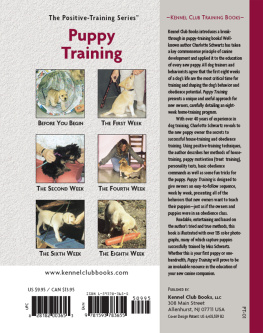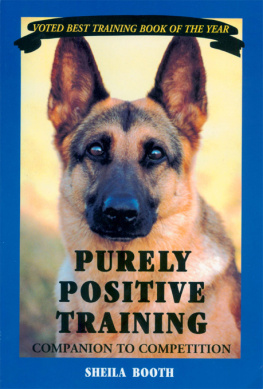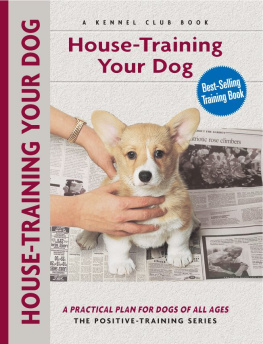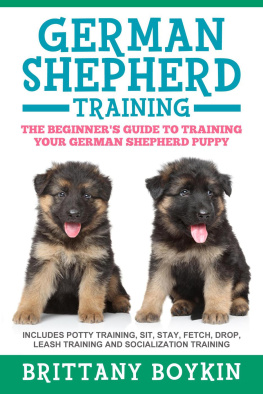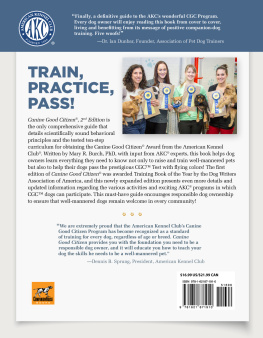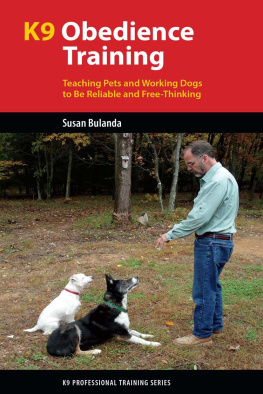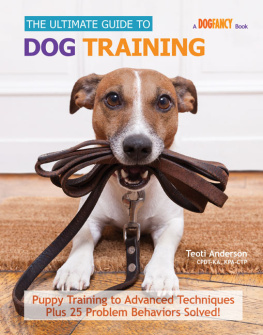ABOUT THE AUTHOR
A former college chemistry professor, Amy Dahl has trained dogs and their owners full-time since 1997. While Amy has trained dogs to obedience and hunting test titles, most of her work is with family pets and hunting buddies. She believes the key to good behavior is giving owners the tools to motivate and communicate with their dogs. Amy writes a regular column in Just Labs Magazine, and her training articles have appeared in other publications in the US and abroad.
ACKNOWLEDGEMENTS
T his book could not have been written without the support, encouragement, and discussions with a number of people. Foremost I want to thank my family, John, Ruth, and Charles, for their patience and help doing my chores as I wrote. I have also learned a great deal about dog training from John, and had many productive discussions with him on the subject. The book is much better thanks to Johns critical reading of the manuscript, and I thank him for his time and careful attention.
Ruth took many of the pictures, while Ruth, Charles, and their dogs taught me a great deal about how people and dogs learn together. I also want to thank Stephanie Roberson-Thomas for her photography. Stephanies understanding of composition and how to illustrate training concepts was a great asset. So was her patience and dedication.
Ive learned from many friends and fellow trainers, but want to particularly thank Sue Alexander for many interesting and productive discussions. Sue guided me through my first clumsy attempts at clicker training and has contributed greatly to my understanding of behavior, aggression, and canine learning. Sues willingness to discuss differences instead of criticizing them has made our conversations especially valuable.
My thanks to Christina Maness, Jim Pedersen, Madeleine Burgoyne, Tracy Misero and Hope and Alan Thomas who allowed me to include pictures of their dogs. Thanks also to all of the dog owners who have come to me for training help, and in turn have helped me learn to talk to owners about dogs.
Thanks to Skip Huckaby for his insight and encouragement. Thanks to Eric and Ann Cartwright and Melanie Foster for decisions that they made.
This book would not have come to be without Tom Petrie and Willow Creek Press. They believed in this book and encouraged me to write it, and lets just say I never knew anyone could be so patient.
Thanks to those who will never read thisthe dogs. Above all, thanks to my first dog, Shasta, who made me a dog trainer and taught me a heck of a lot about love and life. Thanks especially to the other dogs whose stories are told in the book, Smoky, Salty, and Laddie.
P uppies are cute and adorable, but can be hard to manage. They chew, get into things they shouldnt, and make messes. They require housebreaking, training in manners, and exposure to a variety of people and places, referred to as socialization, in order to become pleasant companions as adults.
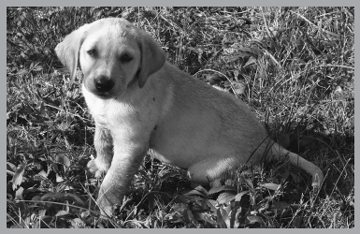
With an understanding that puppy behavior is developmentally normal and a plan, you can enjoy your puppy, confident that she will develop into a pleasant adult. I will outline a sound method of housebreaking, advise you on socializing your puppy, identify behavior your puppy will outgrow with little effort from you, and give you tips to gently gain control over future adult behavior. I will also suggest constructive and fun activities, including an obedience introduction tailored to puppy attitude and attention span.
The goals of this book are to help you manage and enjoy your dog. In order to fully enjoy your dog, you will have to recognize that your puppy is not a blank slate, but an individual, many of whose personality traits are genetically determined. Trying to force a dog to change her nature is frustrating; accepting her individuality, and identifying and molding those aspects of behavior that you can modify, is a worthy and fun challenge. Dogs vary, for example, in their activity level, their need for attention, their playfulness, their enthusiasm for unfamiliar people and dogs, their sensitivity to others, and their desire to learn new behavior. Through socialization, we can help an individual become as adaptable and confident as her genes allow. Through training, we can teach manners, a few commands, and solve specific behavior problems. We can use what we learn in training a dog to find activities that will be rewarding for that individual. We will not, however, make an aloof dog into a social butterfly or turn a working-bred dog into a couch potato. Put simply, nature and nurture play complementary roles in the development of an individual dog. Putting our efforts into those things we can change, while accepting the rest, is essential to enjoyment of our dogs.
Perhaps the most pressing project with a new puppy is house-training. I recommend using a dog crate in housebreaking your puppy. In brief, this method makes use of a puppys natural tendency not to soil the place where she sleeps. When confined to a small area, a puppy will hold it. Then when you take her out, she is primed to relieve herself. By taking her to the same place every time, and praising her when she urinates or defecates (pees or poops) there, you can quickly teach her to go in that one place.
Following that, she will not need to relieve herself again for some time. Depending on her age, breed, and disposition, she might be safe for ten minutes or for an hour or two. During this time she can be at large in the house with little risk she will develop the bad habit of soiling rugs, furniture, etc. Using this approach it is possible to house-train a puppy without any punishmenta big benefit as punishment is easily misunderstood and can lead to house-training problems.
A dog crate can be an excellent tool to help teach your puppy citizenship. Many instances of problem behavior arise from inattentiveness to a puppy or dog. When the owners attention is elsewhere, the puppy tries various things to get attention. The most obnoxious actions are rewarded with the owners attention, and the puppy learns offensive behavior. By confining your puppy safely in a crate at times you must attend to something else, you can ensure that when she is out, you can concentrate on selectively rewarding her good behavior.
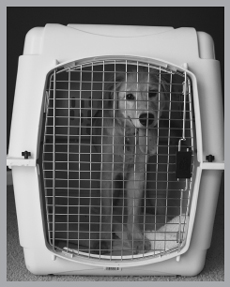
Puppy in crate.
Most dogs seem to enjoy having a space that is their own, especially a small, enclosed space. Many owners keep a crate in the house when their dog grows up, sometimes removing the door, and find their dogs voluntarily spend time resting there.
One other benefit to familiarizing your puppy with a crate is that if the circumstances of her life require her to be confined to a crate at some point, the crate will be a source of security rather than of stress. She might need to spend time in a crate to recover from an injury or surgery, or in order to travel.
Choose a crate that has enough room for your puppy to stand up, turn around, and lie down, plus a little to allow for growth. The crate should not be so big that your puppy can curl up in one end with a big space at the other, as she may see a big space as a good toilet area.
These tips will make house-training easier, faster, and more pleasant for you and your puppy. For an adult dog, this same method works as well or better, because they have better bowel and bladder control than puppies.
One of the biggest challenges to crate training is a puppys limited ability to hold it overnight. Getting up at night costs you sleep, may be an ordeal depending on the season and temperature, and may tempt you to cut corners such as letting her out the door instead of going out with her. Or you may be a heavy sleeper and fail to get up. The resulting mess is no fun to clean up and is not a training success. There are several things you can do to improve your puppys nighttime control.


